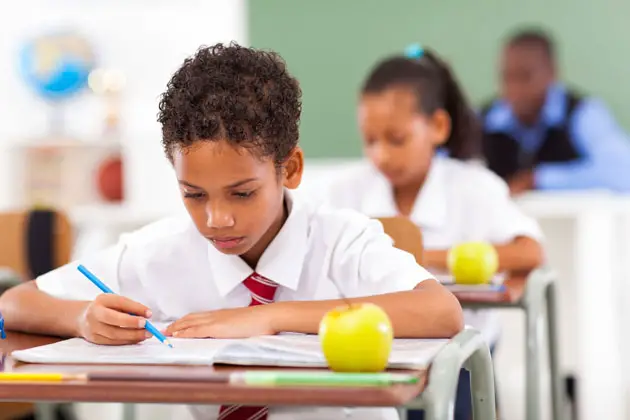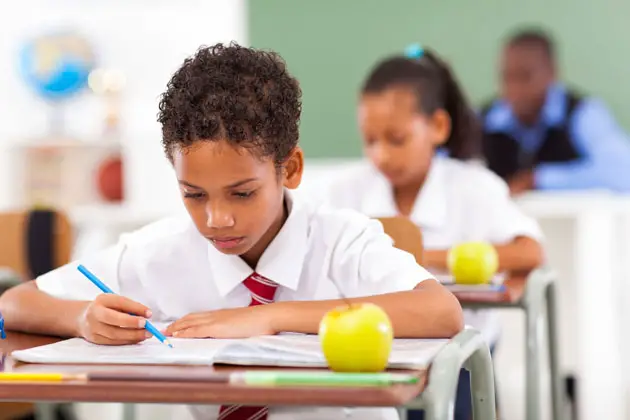M. Morris’s daughter, a ninth grader in East Hanover, NJ, has been doing well academically since her school went all remote in March 2020. She was able to maintain honor roll and she even earned a distance learning award at her eighth-grade graduation. Her social life, however, is a different story. “She is a social person and greatly misses the daily interactions with her friends and teachers,” Morris says. “She typically performs in the school plays and musicals. She hasn’t done so this year and really misses it.”
Many parents will agree: Remote learning has been rough. Whether kids are in a hybrid or an all-remote model, schooling online has taken a toll—but it hasn’t been all bad. We spoke to several local parents about their kids’ experiences—both positive and negative.
The Negative Effects of Remote Learning
Just like Morris’s daughter, many kids are craving social connections and idle chatter with peers in class, recess, lunch, or the hallway, all of which can’t happen online. “Kids need to see other kids to form their identity, and they aren’t getting that opportunity,” says Dara Duryea, LCSW, child and family therapist in Succasunna, NJ. “The kids I see are getting grumpy and acting out more at home due to not having interactions with peers.”
Rachel S. from Queens says that being home so much has made her daughter quieter. “On days when my daughter is in school, she can’t really be a kid and have fun.” Students in the city are even more isolated. “Many students say they don’t leave their apartments for several days,” says Wendy B., who teaches in an all-girl public school in East Harlem. “Their social lives are primarily on screens.”
RELATED: Why Summer Camp is More Important Than Ever
Unfortunately, remote learning has also led to students—especially those with special needs—falling behind. “I’ve noticed a lot of regression in some special needs students who don’t attend live synchronous teaching regularly and don’t have support at home,” says K. Gargiulo, who teaches remote special education to students in kindergarten through third grade in New York City.
Michele S. in Montclair, NJ struggles at times to get her middle-school daughter, who has ADHD and anxiety, to keep her computer-camera on and take notes. She often has difficulty with her school-issued Chromebook or with navigating teachers’ glitchy internet connections. She can’t meet peers in her new school, which has made her frustrated and disinterested. “My once enthusiastic learner has completely changed,” Michele says. “While she seems to enjoy some of her classes and teachers, overall, she is unmotivated, disengaged, and often does the least work possible. She has hit a wall. Her attitude is one of ‘who cares’ and ‘this doesn’t really matter.”’
Even students who normally thrive are having trouble with academics. “My daughter is only 7 and has said to me numerous times, ‘Mom, I’m not learning anything,’” says Rachel S., whose daughter has only been to school in person 15 days this school year. In fact, the second grader previously never had an issue doing homework. “Now, it’s like pulling teeth.” Hiring a tutor has helped, but, as Rachel stresses, her daughter needs consistency. “It’s hard for her to concentrate at home,” she says. “We live in an apartment and we’re on top of each other. She is easily distracted by us and her toys being right there.”
Many kids can’t focus in front of a computer for long hours or independently track their work pace and Zoom schedules. And teachers are having trouble monitoring their students’ progress. A physics teacher of 14 years at a Bergen County, NJ high school, says she can’t tell who is completing their own work or who may be cheating. Still, she sings her students’ praises. “The majority of my students can manage their time and workload and have risen to the occasion,” she says. “They’re comfortable reaching out for help when they begin to fall behind.”
Jaime Tan, a teacher in Rockland County, says she’s discovered that students really want to be in school. “They leave my class on Friday knowing they won’t be back for a week and their faces drop. I want to give them hugs and tell them to keep up the great work at home that they were able to do while they were in the classroom. However, I know the challenges of working from home are much greater than the desire to do well. When school does return to normal, I believe kids will have a new appreciation for school.”
And, of course, nothing substitutes learning in a school setting when it comes to hands-on activities. As a chemistry teacher, not being able to have hands-on labs has had the most negative impact on my students,” says Wendy B. “Virtual labs and simulations are okay, but nothing substitutes physically being in the lab and observing, measuring, heating, gathering, and analyzing data with lab partners.”
The Positive Effects of Remote Learning
While many young students are struggling, there are some who are actually thriving with remote school. “Students who prefer working alone are really shining,” says Lena Guroian, who teaches at a Bergen County middle school. The same goes for shy kids, whom Guroian says are perhaps more comfortable participating by typing in chat on Jamboard (an interactive whiteboard system) or Padlet (like paper for the screen). Here, it’s their thinking that stands out—not their physical selves, she says. They don’t have to worry about who they will sit next to at lunch or on the bus—situations that make them anxious. “Kids with school phobia are doing well with remote learning,” Duryea adds.
Many teachers also find that technology is benefiting students. “Some technology I’ve been using to record lessons, give extra help, or share my screen have been helpful and allow accessibility for all students,” the physics teacher says. “I can record lessons and share them with students who are absent or who need help. I can meet with students virtually after school hours for extended help.” Since they have no other choice, students are becoming tech wizards. “I think my daughter’s overall problem-solving abilities have expanded in leaps and bounds, whether it’s figuring out some IT issue on her computer or doing research online,” says Michele S.
Fortunately, most kids will get back on track. “The great thing about children is that they’re resilient,” Duryea says. “I’m hopeful that this will become a blip on the radar of their lives,” Guroian adds. “Our students can do catch up if they have the support, motivation, and drive to do so.”
Heather, a New Jersey-based mother of two boys in elementary school and an educator herself, thinks kids’ future success will also depend on their parents. She hired a reading tutor for her younger son, and she and her husband adjusted their work schedules to oversee remote learning. “We, as parents, will continue to support our boys the best we can,” she says. “We’ll give them experiences that encourage their sense of wonder and eagerness to learn. We have the means to do this, both financially and emotionally,” she says. “Many cannot.”
Amy Giesler, a licensed clinical social worker, school-based clinician, registered play therapist, and mother of two from northern New Jersey, summarized it well: “Many children, families, and teachers will emerge from the remote learning experience with new knowledge, skills, memories, and appreciation for the traditional learning environment,” she says. “Values like teamwork, flexibility, and self-discipline have all been promoted through remote learning. Perhaps the most important lesson learned is one that can't be taught through books—the importance of hope, perseverance, and optimism during dark times.”




















